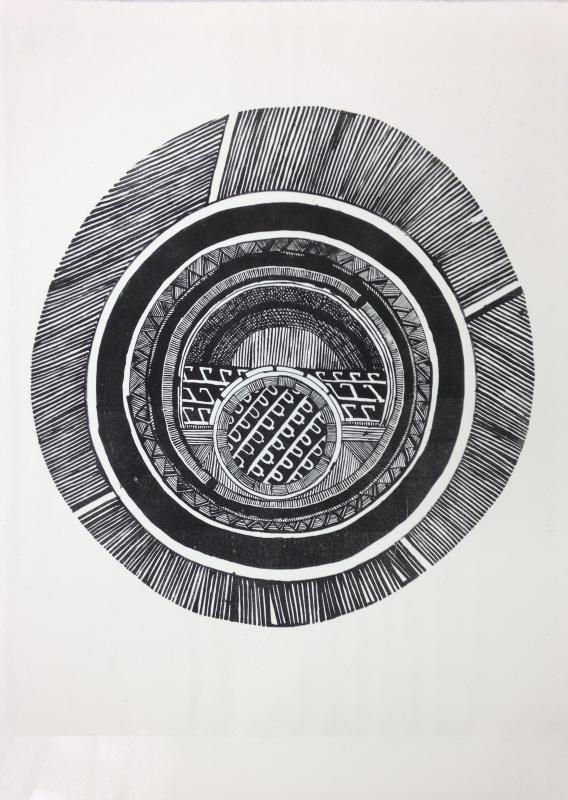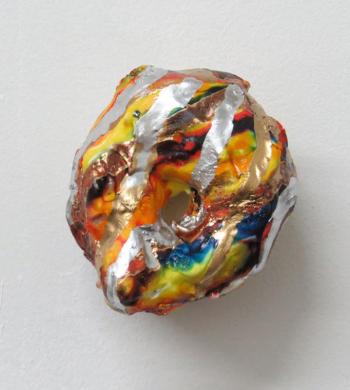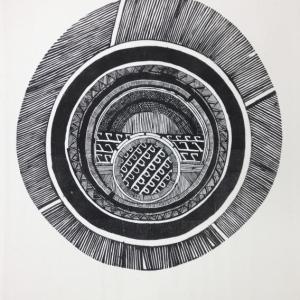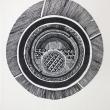Into the unknown: Down the Donut Hole
 The opening night crowd to the “Hole History: Origins of American-Style Donut” show at Asymmetrick Arts in Rockland on June 3 (National Donut Day) which runs to June 25. (Photo courtesy Alexis Iammarino)
The opening night crowd to the “Hole History: Origins of American-Style Donut” show at Asymmetrick Arts in Rockland on June 3 (National Donut Day) which runs to June 25. (Photo courtesy Alexis Iammarino)
 Plaque courtesy the Nativity Lutheran Church in Rockport, Maine
Plaque courtesy the Nativity Lutheran Church in Rockport, Maine
 Artist Maria Liebana, Mixed Media
Artist Maria Liebana, Mixed Media
 Artist Rebecca Levi, Lithograph on Rives
Artist Rebecca Levi, Lithograph on Rives
 Artist Jon Merritt, Acrylic on MDF and Masonite
Artist Jon Merritt, Acrylic on MDF and Masonite
 The opening night crowd to the “Hole History: Origins of American-Style Donut” show at Asymmetrick Arts in Rockland on June 3 (National Donut Day) which runs to June 25. (Photo courtesy Alexis Iammarino)
The opening night crowd to the “Hole History: Origins of American-Style Donut” show at Asymmetrick Arts in Rockland on June 3 (National Donut Day) which runs to June 25. (Photo courtesy Alexis Iammarino)
 Plaque courtesy the Nativity Lutheran Church in Rockport, Maine
Plaque courtesy the Nativity Lutheran Church in Rockport, Maine
 Artist Maria Liebana, Mixed Media
Artist Maria Liebana, Mixed Media
 Artist Rebecca Levi, Lithograph on Rives
Artist Rebecca Levi, Lithograph on Rives
 Artist Jon Merritt, Acrylic on MDF and Masonite
Artist Jon Merritt, Acrylic on MDF and Masonite
As the local story goes, in 1847, 16-year-old Hanson Crockett Gregory, a boy from Clam Cove, Maine, (now part of Rockport) was working aboard a ship when he got mighty sick of the way frycakes failed to cook thoroughly in the middle. According to a interview published in the Washington Post in 1916, Gregory, who was by then a retired 85-year-old sea captain said: “Now in them days we used to cut the doughnuts into diamond shapes, and also into long strips, bent in half, and then twisted. I don’t think we called them doughnuts then — they was just ‘fried cakes’ and ‘twisters.’
“Well, sir, they used to fry all right around the edges, but when you had the edges done the insides was all raw dough. And the twisters used to sop up all the grease just where they bent, and they were tough on the digestion.”
The Maine way has always been “Waste Not, Want Not” and Gregory found an innovative solution to those inedible frycake centers.
In the article, he continued: “Well, I says to myself, ‘Why wouldn’t a space inside solve the difficulty?’ I thought at first I’d take one of the strips and roll it around, then I got an inspiration, a great inspiration. I took the cover off the ship’s tin pepper box, and — I cut into the middle of that doughnut the first hole ever seen by mortal eyes!”
Thus, Gregory became in a roundabout way, the inventor of the donut hole. He took his invention home to his parents in Camden and showed his mother, who then promptly made a batch and took it to friends in Rockland.
“Everybody was delighted and they never made doughnuts any other way except the way I showed my mother,” recalled Gregory.
His invention, however, would not go uncontested and according several culinary historians and food writers, many others tried to lay claim to the hole. But throughout history, Gregory’s story of invention has been popularized and perhaps enjoyed the most.
To commemorate Maine’s contribution to the donut hole, an art and public history show, “Hole History: Origins of American-Style Donut” is running through to June 25 (National Donut Day) at two locations: Asymmetrick Arts on 405 Main Street and Win Wilder Hall 328 Main Street in Rockland.
Alexis Iammarino, a Rockland artist, is behind this w(hole) hing. Curating the works of authors, artists, and historians regionally and from all over the country, the two-venue show features a mix of paintings, photographs, written passages, video pieces, and old newspaper accounts of everyone’s favorite deep-fried pastry.
“I’ve reached out to culinary historians who’ve devoted to years of study around the donut hole and who’ve investigated the origins of Gregory’s invention story,” said Iammarino.
Collaborating with local artists Jared Cowan and Josh Cardoso, the event brings out some left-of-center pieces. “The donut-hole is a rabbit-hole leading to awesome and unexpected creative diversity,” said Cardoso. “Putting a void in the center is endlessly generative."
“Sometimes when you do a themed event, the submissions might be somewhat of a stretch to relate to the theme, but artists have been making the donut the subject of their work for decades so, between that and the local creativity we’re bringing to it, this is something that’s fun and engaging for everyone,” said Cowan.
Submissions in the show will feature artists/writers from Maine, New York, California, Oregon, Massachusetts, Maryland, Minnesota, South Dakota, Kentucky, Kansas, Canada and Ireland. The opening reception held at both galleries on June 3 will feature images and narratives relating equally to authenticity, tall tales, and toroid geometry: anything and everything relating to the iconic American pastry. It would also not be complete without donuts made from local bakers whose insides you can bet will be thoroughly cooked. As Gregory might say if he were still around: “Them’s mighty good eatin’.”
Kay Stephens can be reached at news@penbaypilot.com
Event Date
Address
United States



































